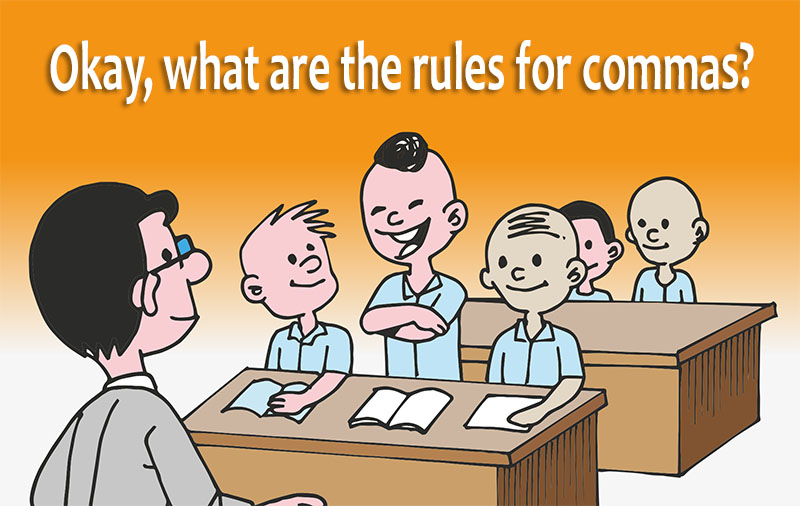What are the Rules for Commas? A comma is a punctuation mark, which is used for several reasons, but mostly the comma indicates a pause in the sentence. By learning the following comma rules, you will be able to confidently place commas in the right position when writing sentences.

What are the Rules for Commas?
The rules for commas are many and varied. However, I find the following nine (9) commas rules usually cover most situations when writing a sentence.
1. Use Commas With Lists
Use commas between words, or groups of words in a series.
David, John, and Joshua had the opportunity to play golf over the long weekend. (a series of nouns)
Mother Theresa fed the tired, hungry people. (a series of adjectives)
David prepared, primed, and painted his daughter’s car. (a series of verbs).
The children loved their mother, cared for their mother, and supported their mother while she was sick. (groups of words in a series)
2. Use Commas to Set Off Certain Words
Use commas to set off nouns of direct address, nouns in apposition, and words such as “yes,” “no,” “however,” and “well.”
Peter, please come over here and help me with this. (direct address)
Mr Benson, our bank manager, has been very helpful during our financial crisis. (in apposition)
Yes, I had a time of my life at the football final! (words such as yes)
However, I spent a lot of money on food. (words such as however)
3. Use Commas To Join Independent Clauses
Use a comma before the coordinating conjunction which connects the two independent clauses. The coordinating conjunctions are: and, but, yet, nor, or, and for.
Dad traveled to the city, and he bought a new vehicle. (connecting two independent clauses with coordinating conjunction, and)
The deal must be made clear, or the man would not buy the vehicle. (connecting two independent clauses with coordinating conjunction, or)
4. Use Commas To Separate Direct Quotations
Use a comma to separate a direct quotation from the rest of the sentence.
The teacher said, “Follow my lead.”
“Hey you,” said the policemen, “Stop, or I will shoot!”
Mum asked, “Would you like chicken for dinner tonight?”
5. Use Commas For Greetings and Closure of Letters
Place a comma after the greetings of friendly letters and the closings of all letters.
Dear Rebekah, (Greetings of a friendly letter)
Sincerely Yours, (Closing of all letters)
6. Use Commas To Separate Certain Parts of a Date
Use commas to separate certain parts of a date when writing them in sentences. Place a comma after the year when it appears in the middle of a sentence.
Sunday, April 25, 1990, was my twenty-first birthday.
On Friday, September 1, 2015, our school opened its new auditorium.
7. Use Commas Between Certain Parts of Address
Use commas between certain parts of an address – city and state, state and country, or province and country. We also add a comma after the state or country when it appears in the middle of a sentence.
Detroit, Michigan, is where my brother lives.
I will travel to Detroit, Michigan, during the school holidays.
8. Use Commas to Set Off an Introductory Adverb
An introductory adverb clause is set off by a comma.
Because David was hungry, he was anxious to eat his dinner.
Since Rachel cleaned the car, her friends have enjoyed their driving experiences.
After fixing the computer, the internet is working much better.
9. Use Commas to Set Off Participial Phrases
An introductory participial phrase is set off by a comma.
Coming to work today, my car had a flat tyre.
Knowing his own ability, the runner turned it on to win the race.
Relating to his previous experience, the builder explained how to fix the problem.
Speaking to the class, the teacher encouraged his students to do well in their exams.
I have updated this article by highlighting the 8 Simple Comma Rules With Examples. You can check out the article by clicking on the following link – 8 Simple Comma Rules With Examples.
Resources For What are the Rules for Commas?
English Grammar in Use by Raymond Murphy
Plain English Handbook by J. Martyn Walsh and Anna Kathleen Walsh
The Only Grammar Book by Susan Thurman
Mastering English Grammar by S.H. Burton
Connect with us on PINTEREST.





